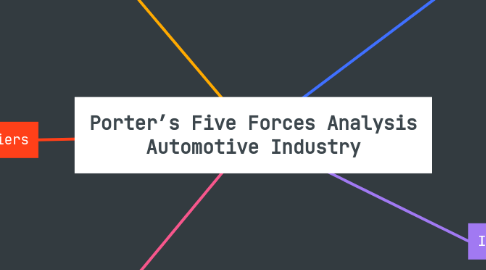
1. Threat of New Entrants
1.1. Barriers to entry in the automotive industry.
1.1.1. High capital investment for manufacturing.
1.1.2. Stringent government regulations.
1.1.3. Established brand loyalty among consumers.
1.1.4. Need for technological expertise.
2. Bargaining Power of Suppliers
2.1. Supplier influence on the automotive supply chain.
2.1.1. Reliance on specialized components (e.g., semiconductors).
2.1.2. Few key suppliers for critical parts like EV batteries.
2.1.3. High switching costs due to customization and reliance on specific designs.
3. Bargaining Power of Buyers
3.1. Customer influence on the automotive market.
3.1.1. Increased demand for affordable and fuel-efficient vehicles.
3.1.2. Availability of alternatives (other brands, EV models).
3.1.3. Bulk purchasing power of fleet buyers (e.g., ride-share companies).
4. Threat of Substitutes
4.1. Impact of alternative products/services.
4.1.1. Rising popularity of electric vehicles (EVs).
4.1.2. Public transportation and ride-sharing options.
4.1.3. Environmental and cost-saving incentives pushing substitutes.
5. Industry Rivalry
5.1. Competition among existing players.
5.1.1. Intense competition among major global players (e.g., Tesla, Toyota, Ford).
5.1.2. Price competition leading to reduced profit margins.
5.1.3. Emphasis on innovation and technology for market differentiation.
5.1.4. Global market share battles driving operational efficiency.
